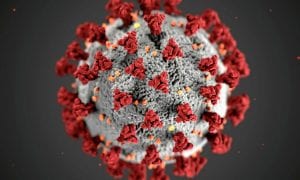
Dozens of residents of Hampden Village gathered in the community hall to watch as the CDC and ADSTR released the findings of a PFAS exposure assessment of Westfield. (PETER CURRIER/THE WESTFIELD NEWS)
WESTFIELD — CDC officials presented a lot of facts and figures, a lot of chemical names and environmental science, and a summary of the history of PFAS pollution in Westfield during a Thursday video presentation.
Viewers at a watch party at Hampden Village left wanting more, however.
Ward 1 City Councilor Nick Morganelli hosted the community event for people to watch the online release of the recent CDC and Agency for Toxic Substances and Disease Registry report about PFAS contamination on the city’s North Side. Dozens of people attended, but many expressed frustration that they hadn’t learned any new information. The results of the study, showing Westfield residents with a high PFAS exposure, were not much of a surprise to most of the room. Many said that they had hoped to hear more information about specific health ailments associated with these chemicals, though the CDC did state it needs further study, because of how long these chemicals remain in the body.
The ADSTR and CDC had collected samples of blood and urine of 459 Westfield residents in 247 North Side households in 2019. The results showed a starkly elevated levels of per- and polyfluoroalkyl substances, also known as PFAS, in Westfield residents as compared to national averages.
Much of the PFAS contamination in Westfield is blamed on the use of AAAF firefighting foam at the Air National Guard base at Westfield Barnes Regional Airport. The foam, once used as a fire suppressant to fight gas fires in hangars contains, high concentrations of PFAS, sometimes called “forever chemicals” because they can take years to break down in nature and can remain in people’s bodies indefinitely, possibly causing negative health effects.
Captain Peter Kowalski of the CDC said that the study also found that older adults typically had higher levels of different PFAS substances, possibly showing how the chemicals can build up in a body over a lifetime. They even found a correlation between the length of time one has lived in Westfield and PFAS bioaccumulation, regardless of one’s age.
One substance in particular, perfluorohexane-sulfonic acid (PFHxS) was found in particularly high levels in Westfield residents compared to other PFAS substances and the national average. It is one of the many chemicals used in the firefighting foam and was once produced by 3M. It is no longer being produced, but it is still being found in human samples.
Kowalski said that the study also pointed to some possible avenues for natural removal of these chemicals from the blood. The exposure assessment found that women typically had lower levels of PFAS in their bodies than men. Though more data is needed, the reason could be a number of factors, including menstruation and breastfeeding. Those who donated blood were also found with lower levels of PFAS compounds.
The CDC’s Tarah Somers said that Westfield residents’ exposure to these substances is no longer increasing, as the use of AAAF foam at Barnes has been discontinued and better filters have been installed at the most heavily affected municipal wells. She said that Westfield’s tap water is safe to drink, and the CDC does not recommend seeking alternate sources of drinking water.
Morganelli said after the presentation that part of the problem with the release of the findings was that it used a lot of technical terms and similar abbreviations, which can become confusing to even the most attentive listener. He said that next time there is a major release of data on the subject, he would like to be able to provide listeners with a simplified packet of information to at least give people more context for what the CDC experts are talking about.
He also said that the exposure assessment should continue, though rather than continuing to measure the PFAS levels in a subject’s body, federal officials should conduct a longer-term study documenting possible health effects of these chemicals.
At-Large City Councilor Kristen Mello, founder of Westfield Residents Advocating for Themselves, said that the frustration being felt by residents is not unexpected. Her group has been vocal about the effects of PFAS exposure and the degree to which Westfield residents have been affected.
“It is not unexpected for residents to feel some disappointment that the findings could not be greater in scope than they were, because we still need so much more to be done,” said Mello, “The parameters of this work limited it to ‘assessing’ whether our exposure was statistically unusual, and if it could be determined to be from the contaminated water and AFFF use at Barnes, and those two findings alone are huge for us.”
She said that focus should remain on limiting exposure to PFAS chemicals, which can also be found in everyday items and appliances like furniture and cookware.
“Many other communities are left where we were two years ago, with what we knew to be true but [with] no one investigating. Residents know there are health impacts happening here. We live them,” said Mello, “Now we must continue our work to monitor and reduce our PFAS exposure, and to get residents the help they need to manage how this contamination has affected their lives and families.”








